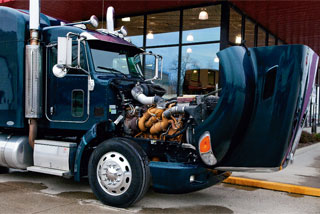|
The bigger they are
An adjuster's look at heavy truck losses
By Dave Willis
Spend any time on the highway and you will face this Goliath. Sometimes it’s in your rearview mirror, a little too close for your comfort. Sometimes you see it—or a convoy of them—up ahead. Worst may be when they are on either side of you.
U.S. government data indicate more than 9 million large trucks—those with gross vehicle weight over five tons—were on the road in 2008, racking up a combined total of nearly 227.5 billion miles. Most of the time, these trucks deliver their goods without incident. Nevertheless, sometimes accidents happen.
According to 2008 statistics from the U.S. Department of Transportation’s Federal Motor Carrier Safety Administration, 3,733 large truck crashes involved fatalities; in 64,000, injuries resulted; and 309,000 were “property damage only” crashes.
When accidents happen, David Miller, AIC, ARM, gets a call. “We pride ourselves on being able to respond quickly and like to beat the police to the scene,” says Miller, a claims adjuster for Crawford & Company in South Florida. “I’ve done it a few times, but they’re usually there when I arrive.” Among the first tasks, of course, is determining and addressing any injuries. Once that’s done, Miller sets about managing the scene.
“Maintaining safety at the accident scene is a big responsibility,” Miller explains. “That’s hard, even with police there.” Lanes often are blocked and traffic is trying to navigate around the wreckage. Rubberneckers heading the opposite direction pose problems, as well.
Preserving and removing spilled cargo is, of course, another issue. “Protecting what is still intact, either covering it up or putting it in a safe place, can be a challenge,” Miller notes. Most of the time, the client does this work, under the adjuster’s direction. “They send another truck or another trailer to get the damaged or salvaged cargo taken away from the scene,” he adds.
“A big problem is guarding the cargo and making certain it’s secure before being removed to a safe location,” Miller says. “If it’s a perishable item, such as groceries or meat, sometimes you just lose it.” With salvageable items, the client or adjuster hires temporary labor to help load the cargo from the roadway onto the new truck.
Sometimes, the public chips in—unfortunately. “I had one case where a 45-foot trailer went out of control on I-95 and lost a shipment of dog food,” he recalls. “The food was in cans, primarily, and paper bags and it was all over four lanes of the roadway.” The event closed the road for nearly six hours. “It happened in mid-afternoon, but that spilled over into rush hour,” Miller adds, claiming no pun was intended.
“The main problem we had was controlling passersby, who were stopping to pick up the dog food and take off with it,” Miller says. “We fought that problem for many, many hours.” It was not the first time he saw the public lend a hand. Early in his career, while working in Indiana, he faced a similar situation after an accident. “A cargo load of Playboy magazines went all over the roadway,” he notes. “They were wrapped in paper bundles but, sure enough, they too were picked up in a very short amount of time.”
In today’s information age, it’s easier than ever to spread word of a spill. “These losses tend to find their way online very quickly,” Miller says. With an increase in the use of social media and social networking, a series of “tweets” and “retweets” can reach hundreds—probably thousands—of individuals in a matter of seconds.
While early response is important, the most critical tasks include fully understanding what happened and determining responsibility, if possible. “The biggest challenge is to find out why the accident occurred and who was at fault,” Miller explains. “Was it the truck driver’s fault or was it someone else’s?”
Answers to some questions lie in the tractor’s electronic data control module. “It’s sort of like the black box in an airplane,” Miller says. “It provides information on the truck’s operating systems before the accident, such as brakes, speed, engine RPMs, things like that.”
Once that’s recovered, a device is plugged into it and data is downloaded. “We can decipher and use that information to determine what the truck was doing before the crash and at the time of the crash,” Miller explains. “Of course, the most important thing we’re looking for is the speed of the truck before the collision, if it was an open road accident, and whether the brakes were applied.”
Sometimes recovering the module is a challenge in itself. “If it goes to a salvage yard or a tow yard, the yard owners won’t let anyone in unless they can prove they own the vehicle,” Miller notes. “So you need to get in contact with the client and get permission to get in there, and then you need to find a technician capable of pulling it out and securing it until the download.”
Another way to understand what happened involves accident reconstruction. “Because these accidents can be severe and the losses complicated, it can be difficult to figure out exactly what caused it to occur,” Miller says. “Whenever possible, I prefer to hire a reconstruction expert who can help reconstruct the accident to determine cause.” Such experts can offer tremendous insight, even to a highly skilled and experienced adjuster.
By better understanding what causes accidents, safety experts and trucking firms can work to reduce both the frequency and the severity of losses that result.
The author
Dave Willis is a New Hampshire-based freelance writer and regular Rough Notes magazine contributor.
|
|
| |
 |
| |
U.S. government data indicate more than 9 million large trucks—those with gross vehicle weight over five tons—were on the road in 2008, racking up a combined total of nearly 227.5 billion miles. |
|